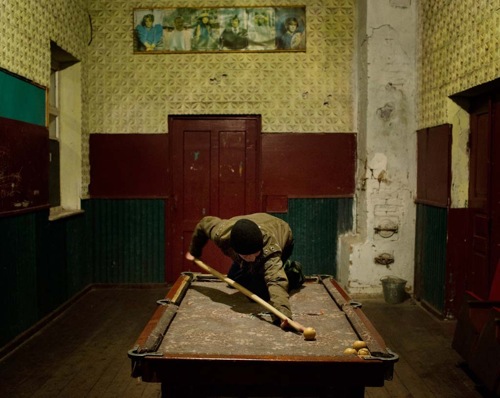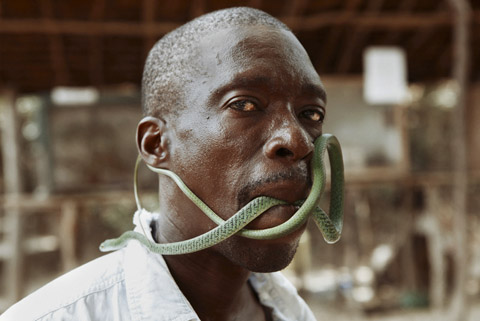“In 1999, as I walked out my apartment, I saw a transformation taking place. New street lights? What is this about? As I searched for answers, I saw and heard of more changes starting to occur in my neighborhood of Bedford-Stuyvesant, Brooklyn (street vendors were being moved, the Franklin Avenue shuttle was being rebuilt and talks of rent in the neighborhood being doubled in ten years were being discussed at community board meetings). Two years prior, I had just started teaching myself how to photograph. With change coming to the community and the stigma of the neighborhood being a slum, I decided to make photographs that would reflect what I saw.
Category: Portfolios & Galleries
-
Live from Bed-Stuy (10 Photos)
-
Growth – wilma hurskainen
Growth is a project in which I reconstructed and re-photographed pictures that my dad took of me and my three little sisters when we were children. I tried to make the new photograph look as similar as possible to the old one: the place and the composition are the same, and so are our positions and facial expressions.
-
Yumiko Utsu’s Disturbingly Kitsch Food Photography
Grotesque yet utterly intriguing, Japanese photographer Yumiko Utsu’s work enthralls the viewer with playful constructions of fruit, dismembered sea creatures, vegetables and insects set against colorful tapestries. Her bizarre and humourous photo-art, revolving around food and animals, falls into the narrow genre of disturbing kitsch that could only come out of Japan.
-
Photographs of a Middle Class Utopia
This series, Middle Class Utopia, focuses in Austrian allotment gardens in and around Vienna, called ‘Schrebergärten’. These tiny gardens were invented in the late 19th century, mainly to provide space for the working class people to grow their own vegetables and fruits. Over the time, the use of these gardens changed and now they are mainly used for recreational purposes.
-
Daniel Milnor: Photographing On His Own Terms
When I look at the best documentary photographers in the world they are very selective about the information they put out. I don’t see Sebastiao Salgado on social media seven days a week. I don’t hear from Salgado every eight minutes. I know when I see something from him it has been well-planned, well thought out and is something I should pay attention to. We live in a world where people value photographers based on how many Twitter followers they have and that just isn’t smart. I love to blog. I’m not a proponent of the “you must post everyday” belief. I try to adhere to what I preach. Say something when I have something to say
-

Parts 6 and 7: Stephen Crowley’s Smoke-Filled Rooms
Looking Back on the Party Conventions
In his sixth and seventh installments of the continuing series “Smoke-Filled Rooms,” the Times staff photographer Stephen Crowley examines the recent presidential nominating conventions.
via Lens Blog: http://lens.blogs.nytimes.com/2012/09/14/an-eye-on-the-party-conventions/
In the sixth and seventh installments of the “Smoke-Filled Rooms” series, Stephen Crowley, a staff photographer at The New York Times, looks back on the conventions, striving to see beyond the restrictions, spin and control of the contemporary American political process. With an unorthodox presentation of photographs and text, Mr. Crowley examines the forces that influence the presidential campaign.
-

Peter DiCampo’s iPhone Photos of Africa
Picturing Everyday Life in Africa
Too often the subjects of images of Africa seem to be reduced to symbols — viewers do not encounter them as fully rounded human beings, rarely seeing journalistic images of the middle class, artists or the cultural heritage of African countries. Peter DiC
via Lens Blog: http://lens.blogs.nytimes.com/2012/09/17/picturing-everyday-life-in-africa/
I realized that I had to keep doing it, because there’s a constant barrage of imagery of misery, despair and hopelessness, and more than any of those things — helplessness, the idea that Africans need to be saved
-

“The Human Condition,” an Exhibit by Peter Turnley in Paris
Four Decades of Photographing the Human Condition
In an exhibition in Paris, four decades of Peter Turnley’s photographs are on display from around the world, encompassing major conflicts and quiet, quotidian moments.
via Lens Blog: https://archive.nytimes.com/lens.blogs.nytimes.com/2012/09/12/forty-decades-of-photographing-the-human-condition/
As important as these images are to him, Mr. Turnley said, so too are the photographs he has taken of the more mundane moments in people’s daily lives. A great admirer of photographers like Robert Capa and Edward Boubat, Mr. Turley said he considered himself neither a war correspondent, like the former, nor a “peace correspondent,” as the latter was called. “One might say I am a correspondent of life,” Mr. Turnley said.
-

Photaumnales 2012 : Guillaume Herbaut
“Before me a snow-covered bridge, the bluish evening light and wolf tracks, I have spent the past two days in the forbidden zone of Chernobyl. I didn’t want to come back here. I had spent too much time here between 2009 and 2011. Four months losing myself in this forbidden place that has fascinated me since my first trip here in 2001. I am drawn toward it and repulsed at the same time..
-

Poulomi Basu’s Photos of Women Serving the Border Security Patrol
On India’s Border, a Changing of the Guards
In 2009, Poulomi Basu learned that India was recruiting women for its patrol of the border with Pakistan. Inspired, she followed this new paramilitary force through training and after, resulting in the project, “To Conquer Her Land.”
via Lens Blog: http://lens.blogs.nytimes.com/2012/10/01/on-indias-border-a-changing-of-the-guards/
Photographer Poulomi Basu said she got the idea after reading a newspaper article in 2009: India for the first time was recruiting women to serve in its Border Security Patrol, training them to police the country’s long and dangerous boundary with its archenemy, Pakistan.

